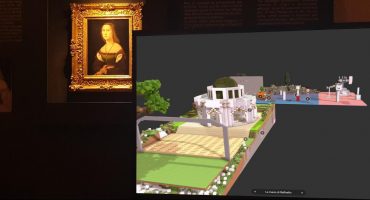About
Socle
Socle is a digital creative agency dedicated to the application and use of new imaging technologies. It is made up of two departments: Collections, which specializes in data collection, digitization and 3D modeling, and arts+spaces, which is dedicated to the creation of immersive experiences and innovative projects for artistic and cultural circles.
Background
Victor Guénard and Luca Fixy founded Socle in 2019. They co-founded Socle upon their common vision, aesthetics, tech affinities, and friendship. They are engaged in supporting cultural and artistic activities. Socle has since expanded their team, collaborating with artist Filip Skrapic on various projects.
Victor is the head account manager and looks after the projects for them to succeed. He graduated as an Architect and was working for a Paris-based agency. Having always been interested in the art world, Victor began collaborating on projects with a diverse group of artists.
Luca is head of projects at Socle. He was previously a project manager at Mazarine Digital for luxury and fashion brands. After obtaining his master’s degree in Information Systems (Big Data) and completing several hackathons (in IA, XR, NLP, etc.), he was introduced to the field of 3D.
How it started
In 2019, Socle began 3D scanning sculptures, bas-reliefs, furniture, and other objects to create a private catalog for curators to consult. It turned out that Sketchfab matched our needs perfectly. It allows its users to share 3D files and to view objects in depth, from anywhere, at any time. It facilitates the process of creation, exchange, and dialogue as easily as WhatsApp.
The pandemic and the lockdown accelerated the transition to fully virtual exhibitions.
Guimet virtuel
In continuation of its program of digital projects, which began during the first lockdown, The National Museum of Asian Arts – Guimet (MNAAG) presents a new virtual exhibition: “The history of Chinese porcelain told through the works of the MNAAG”.
Conceived as an immersive experience at the crossroads of a guided tour and a journey, it is an opportunity to discover a part of the exceptional richness of the museum’s collections and to explore nearly a thousand years of technical and stylistic evolution.
Visitors can walk through an identical replica of the iconic Khmer hall. They also have access to three fantastic original scenes, which offer an augmented visualization of the detailed landscapes on the porcelains. It is a unique selection of roughly 40 porcelain pieces from the museum’s collections, presented for the first time in a 3D environment.
Producing the experience
We began by digitizing the works via photogrammetry. This process involves taking many high-definition photos all around the work, from all angles.
These photos are then interpreted by photogrammetry software to obtain a digital copy of the work. The model created is very heavy. It is then optimized to be integrated into the real-time experience.
The centerpiece of the museum, the Khmer courtyard, was reproduced in 3D using numerous reference photos and architectural plans. Scenography and optimized works were then placed within this reconstituted space. We created an interactive experience to allow viewers to experience the artwork in a dynamic, new way.
3D Softwares we used: Agisoft, Substance, Blender, Unreal Engine.
Why Sketchfab?
Sketchfab was a great help in this production during the meetings with the museum. Once the post-production operations had been completed, Sketchfab allowed us to adjust the parameters of the materials’ gloss and easily share the photogrammetry results with the museum.
We also utilized the Sketchfab x Unreal Engine integration to optimize our workflow.
The works will be accessible online on the museum’s website (coming soon) using the Sketchfab Viewer playlists.
The use of AR will be interesting to develop phygital experiences, where online and offline experiences melt.
The future of 3D museums
With Sketchfab, museums will be able to create a large catalog of 3D scanned works, whether they are on display or in reserve, and easily share them with the rest of the world. Digitization of collections will allow museums to exchange works for projects and facilitate the production of virtual exhibitions.
In virtual exhibitions, visitors can enjoy an unprecedented proximity to collection items, without display cases or barriers interfering with their viewing experience. They can get closer and manipulate the work while admiring the reflection of the light on its surfaces.
While some of the sensations of a physical visit can only be approximated, the digital experience brings an added value to the presentation of the works. It is a new format of mediation and diffusion of culture that offers new possibilities.
Getting started in 3D
1/ First think about what you want to achieve and start with the simple things. This will help you not get lost in all that is available on the market.
2/ Take inspiration from experienced artists, whose work can be found on Sketchfab in particular.
3/ Consider taking training to further your knowledge—have fun and the rest will come with time!
Our favorite models on Sketchfab



